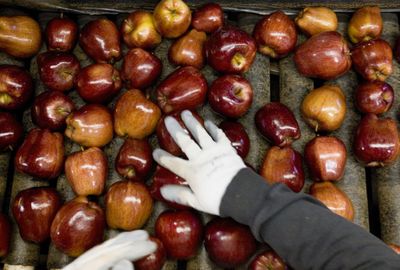Apple prices drop amid record crop
Proportion of larger retail-friendly apples falls

YAKIMA – Apple prices are falling under the weight of a record crop that is composed of too many small apples.
Larger apples, preferred by retailers, are holding their own in some varieties. But prices for smaller apples have dropped below the cost of production.
Average prices for Red Delicious apples are under $13 per box, meaning growers are losing money with every box sold.
“Reds have taken a beating. At those levels, that is below break-even,” said Dan Kelly, assistant manager of the Washington Growers Clearing House in Wenatchee, an organization that tracks prices for its members. “People aren’t doing that well if you look at the overall price. Some sizes and grades are doing better.”
In general, growers are breaking even at prices around $15.50 per box.
Keith Mathews, executive director of the Yakima Valley Growers-Shippers Association, said growers who have a majority of smaller fruit aren’t going to see much return this year.
“They won’t be covering their costs back to the orchard. It will be an actual loss of cash,” he said.
Diverting fruit to processors as an alternative to the fresh market isn’t attractive with cash processing prices around $20 per ton, one year after a strong processing market returned 10 times that much.
Processing prices are dampened by an influx of Chinese apple juice concentrate.
On average in recent years, small apples, those of 113 size – a measure more of weight than circumference – and smaller have made up about a quarter of the fresh crop. A box of apples made up of that size fruit has 113 apples in the box.
This year, the small fruit makes up an estimated one-third of total production.
Washington state exports about 30 percent of its apple crop annually, some 29 million boxes last year. Major markets are in North America, but apples also are sold around the globe.
Market conditions and the unexpectedly large crop have renewed discussion about finding a better way to judge how much fruit will be produced.
The industry badly missed the mark in 2008. As of April 1, the indicated fresh crop is 110 million boxes, almost 11 percent more than was projected prior to harvest, according to the Yakima Valley Growers-Shippers Association.
The industry estimate was right on for the 2007 harvest, ultimately shipping about 2 percent more fruit than was projected during the summer.
Estimates were further off for the 2005 season, when shipments exceeded the summer estimate by 6 percent and in 2006 by 7 percent. Some of those differences, however, depend on market conditions during the marketing season. High demand for certain varieties would result in more apples being packed for sale than was originally projected.
Devising a better system may be difficult in such a diverse industry. Apple production is spread across several counties with increasingly higher-yielding planting systems. Age of trees plays a role, as does orchard ownership structures, ranging from individual growers to vertically integrated major warehouses that pack a majority of their own fruit.
Allan Schmidt, a Zillah grower and clearing house board member, said many variables affect how much ends up in the bin.
“There are so many young trees in the ground. It’s hard to get a good estimate when they are so young,” he said. “The new stuff replaced older trees that might have picked 30 to 40 bins per acre. The new stuff can pick 50 to 60 bins per acre.”
Some attempts have been made, Kelly said.
The industry had a U.S. Department of Agriculture grant to use remote sensing by satellite to estimate the crop. The grant ran out, and no more work is being done.
Another concept in current research is using robots that take photos of the location of fruit on the tree in a project aimed at mechanical harvesting. The technology could help in accurately estimating the crop.
Jim Doornink, a Parker Heights grower and chairman of the Washington Tree Fruit Research Commission, said development of that technology could be helpful but is still years away.
“We’d like to do that at multiple times of the year. If you could do that with enough accuracy, we could get a growth rate and then have a predictive model to zero in on how much fruit you have,” he said.
The commission uses assessments on fruit sold to finance research. The commission committed more than $2 million to research in 2008.